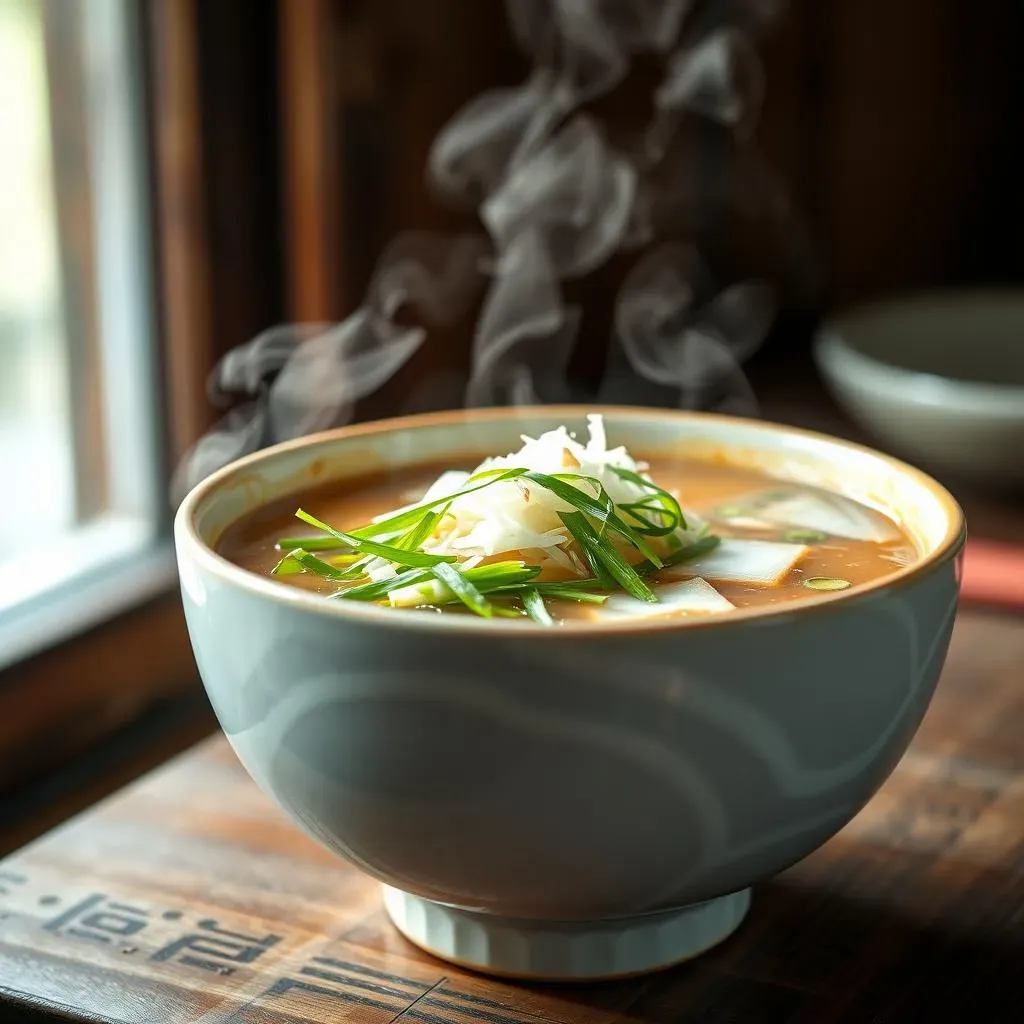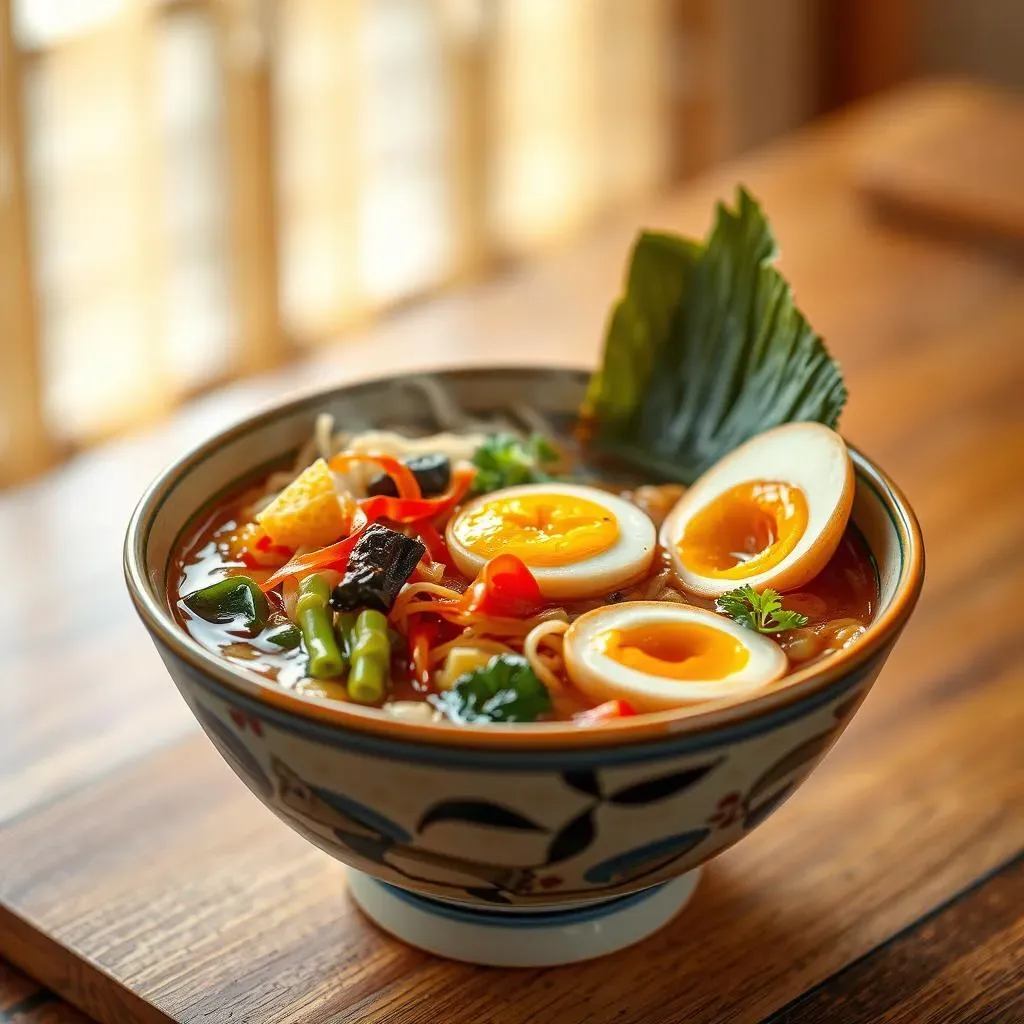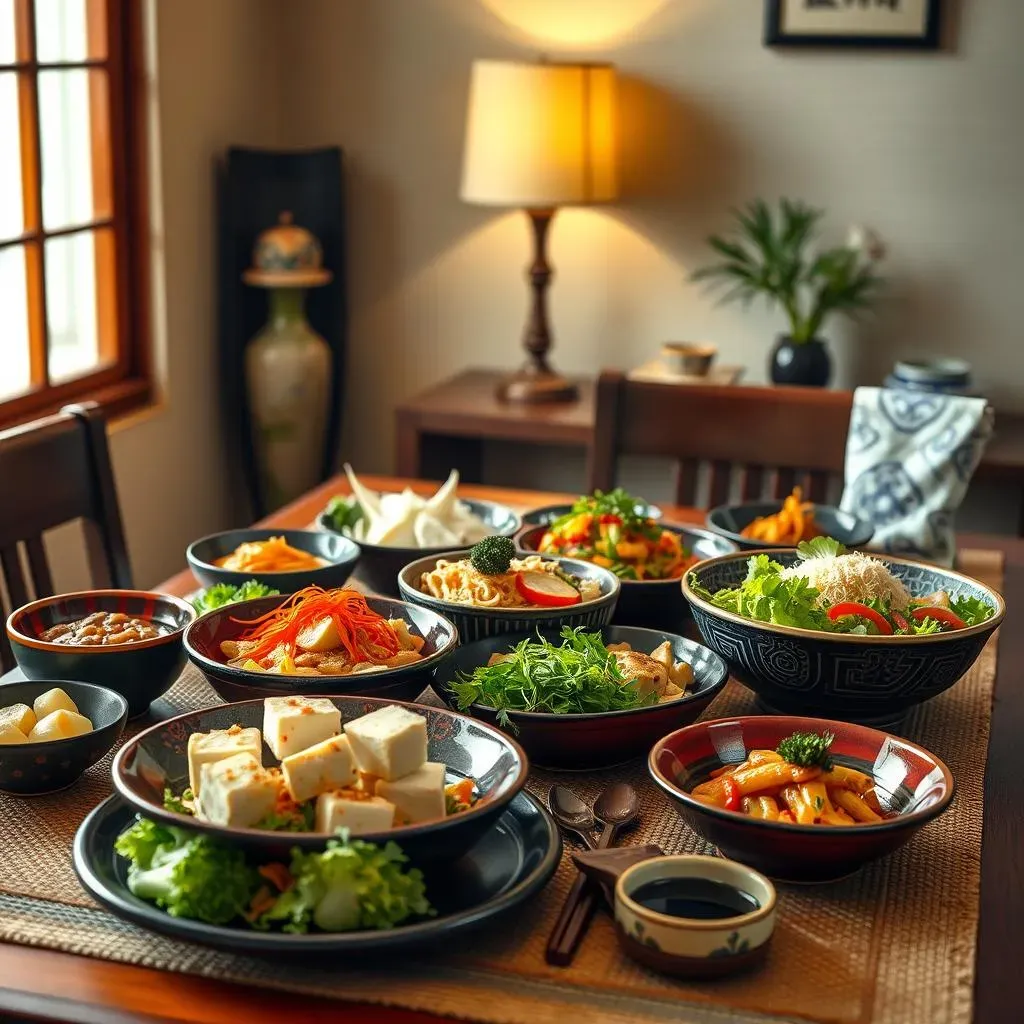Table of Contents
Thinking about diving into the world of Japanese food but skipping the meat? You're in for a treat! Japanese cuisine isn't all about seafood and beef; it boasts a fantastic variety of flavorful, plant-based options that are just as exciting. This article is your guide to the best vegetarian Japanese dishes, taking you beyond the usual suspects. We've gathered 15 amazing recipes, each with its own unique character and taste. From comforting noodle bowls to crispy delights and savory curries, there's something for every palate. Get ready to explore the diverse and delicious world of vegetarian Japanese cooking. We’ll show you what makes each dish special, and how you can easily make them at home. By the end, you'll be equipped to create your own Japanese vegetarian feast, proving that meat-free meals can be every bit as satisfying and delicious. So, let’s get cooking and discover the wonderful world of vegetarian Japanese food!
Discovering Delicious Vegetarian Japanese Dishes
Discovering Delicious Vegetarian Japanese Dishes
A World Beyond Sushi
When people think of Japanese food, they often picture sushi or ramen with meat, right? But guess what? There’s a whole other universe of incredible vegetarian dishes waiting to be discovered. It’s like finding a secret level in your favorite video game, but instead of power-ups, you get amazing flavors. We're talking about dishes that are not just afterthoughts, but are deliberately crafted with incredible taste and textures. Think beyond the usual, and you’ll find a fantastic selection of plant-based meals that are true masterpieces.
I remember my first time trying a proper vegetarian Japanese meal; it blew my mind. I had always assumed that Japanese cuisine was heavily reliant on fish and meat, but I was so wrong. The depth of flavor and the variety of ingredients were astonishing. It was like a whole new culinary world opened up to me, and I was instantly hooked. This is why I'm so excited to share these amazing vegetarian options with you!
The Magic of Umami
What makes these vegetarian dishes so special? It's all about umami. This is that savory, rich flavor that makes you go "mmm," and it's a cornerstone of Japanese cooking. Instead of relying on meat, vegetarian dishes use ingredients like mushrooms, seaweed, and fermented soy products to create that depth of flavor. Think of it like this: if salt is the bass guitar in a band, umami is the smooth saxophone solo that makes the whole song groove. It’s a flavor that's hard to describe but impossible to ignore, and the chefs are masters at using it.
For instance, take a simple bowl of miso soup. It's not just salty; it's got this incredible depth that comes from the fermented soybeans and often seaweed. It’s a perfect example of how vegetarian Japanese cuisine can be both simple and incredibly satisfying. I personally love how a single bowl can be so comforting and full of flavor, it’s my go-to on a cold day.
Ingredient | Umami Source | Common Use |
|---|---|---|
Shiitake Mushrooms | Natural Glutamates | Soups, Stir-fries |
Kombu (Seaweed) | Glutamic Acid | Dashi Broth |
Miso Paste | Fermented Soybeans | Soups, Marinades |
Tofu's Time to Shine
Let's talk about tofu, which is a total rock star in vegetarian Japanese cooking. It's not just some bland, squishy thing, but a versatile ingredient that can take on all sorts of flavors and textures. You can find it silken and soft, perfect for creamy sauces, or firm and fried, adding a satisfying crunch. It’s like the chameleon of the food world, adapting to whatever flavors you throw at it. I was skeptical at first, but now I can’t imagine cooking without it.
One of my favorite ways to enjoy tofu is in agedashi tofu, where it’s fried to a golden crisp and served in a savory dashi broth. It’s a dish that showcases how simple ingredients, when prepared well, can be unbelievably delicious. It's dishes like this that changed my view on tofu forever. So, don’t underestimate this ingredient; it’s a real game-changer in Japanese vegetarian cuisine.
MustTry Vegetarian Japanese Dishes: A Culinary Journey
MustTry Vegetarian Japanese Dishes: A Culinary Journey
Ramen Without the Meat
Alright, let's talk ramen, but hold the pork! Yes, you heard right, you can have amazing ramen that's completely vegetarian. Forget everything you think you know about broth because this is where the magic happens. Instead of a heavy meat-based broth, vegetarian ramen uses a flavorful combination of kombu (seaweed), shiitake mushrooms, and other veggies to create an incredibly rich and satisfying base. It's like a warm hug in a bowl, and it’s totally customizable with various toppings.
I remember the first time I tried a veggie ramen, I was totally surprised by how flavorful it was. The broth was so deep and savory, I didn't even miss the meat. I added some bamboo shoots, spinach, and a soft-boiled egg (if you're not strictly vegan) and it was pure comfort food. It's now one of my go-to dishes when I need a quick and satisfying meal. Seriously, if you haven’t tried it yet, you’re missing out on a whole new level of ramen goodness.
Gyoza Goodness: Veggie Style
Next up, let’s talk about gyoza! These little dumplings are usually filled with meat, but the vegetarian versions are just as delicious, if not more so. Imagine a delicate, crispy wrapper filled with a savory mixture of finely chopped vegetables, tofu, and maybe some glass noodles. They're pan-fried to perfection, giving you that satisfying crunch with every bite. It’s like a party in your mouth, and everyone's invited!
I love making gyoza at home with my friends, it's a fun and interactive cooking experience. We usually fill them with a mix of cabbage, carrots, mushrooms, and some ginger for a little kick. Dipped in a soy sauce and rice vinegar mixture, they are absolutely irresistible. They're perfect as an appetizer or as part of a larger meal. Trust me, once you start making vegetarian gyoza, you won't want to stop, they're that good!
"The secret ingredient is always love... and a good dipping sauce!" - Anonymous Gyoza Lover
Dish | Main Ingredients | Flavor Profile |
|---|---|---|
Vegetarian Ramen | Kombu, Shiitake Mushrooms, Vegetables | Savory, Rich, Comforting |
Vegetarian Gyoza | Cabbage, Tofu, Mushrooms, Ginger | Savory, Crispy, Flavorful |
Making the Best Vegetarian Japanese Dishes at Home
Making the Best Vegetarian Japanese Dishes at Home
Stocking Your Pantry: Essential Ingredients
So, you’re ready to bring the magic of Japanese vegetarian cooking into your own kitchen? Awesome! First things first, let’s talk about stocking your pantry with some essentials. Think of it like gathering your tools before starting a really cool project. You'll want to have things like soy sauce, which is the backbone of many Japanese dishes, and rice vinegar, which gives that perfect tang. Miso paste is a must for that umami depth, and don't forget about dried seaweed like kombu and nori. These are the building blocks for some seriously delicious meals.
I remember when I first started, my pantry was a hot mess. I had no idea what half the ingredients were, and I was constantly running to the store. But after a few trial and errors, I finally got the hang of it. Having these essentials on hand not only saves you time but also inspires you to try new recipes. It’s like having a little piece of Japan right in your own home.
Mastering the Basics: Dashi and Beyond
Next up, let’s talk about dashi. This is the heart and soul of many Japanese dishes, and it's surprisingly simple to make vegetarian-friendly. Instead of using bonito flakes, you can create a rich dashi using kombu and shiitake mushrooms. It's like brewing a flavorful tea that forms the base for soups, sauces, and more. Once you master dashi, you’re halfway to becoming a Japanese vegetarian cooking pro. Trust me, it's easier than you think.
My first attempt at making dashi was a bit of a disaster, I ended up with something that tasted like muddy water. But after some practice (and a lot of online tutorials), I finally nailed it. The key is to use good quality ingredients and to be patient. Dashi is the secret weapon that elevates even the simplest dishes. It's like the secret handshake that unlocks the true taste of Japanese cuisine, and it’s a game-changer for vegetarian cooking.
Essential Ingredient | Why It's Important | Where to Use It |
|---|---|---|
Soy Sauce | Adds saltiness and umami | Sauces, marinades, dips |
Rice Vinegar | Adds tanginess | Dressings, sushi rice |
Miso Paste | Adds depth and umami | Soups, glazes |
Kombu (Dried Seaweed) | Base for dashi | Broths, soups |
Nori (Dried Seaweed) | Adds flavor and texture | Sushi, onigiri |
Simple Techniques, Big Flavors
Now that you have your pantry stocked and your dashi skills down, let’s talk about simple cooking techniques that can make a big difference. Japanese cooking isn't about being fancy, it's about using fresh ingredients and simple methods to bring out the best flavors. Things like stir-frying vegetables quickly to maintain their crunch, or simmering sauces slowly to allow flavors to meld together. It’s all about balance and harmony, like a perfectly tuned instrument.
I've found that the more I focus on these simple techniques, the more I enjoy cooking. It's not about being a gourmet chef, but about being mindful of what you're doing. And remember, cooking should be fun! Don't be afraid to experiment, make mistakes, and most importantly, enjoy the process. It's all part of the journey of becoming a better home cook, and each mistake is a lesson in disguise.
"The best dishes are often the simplest, made with love and attention to detail." - Anonymous Home Cook
Tips and Tricks for Enjoying Vegetarian Japanese Food
Tips and Tricks for Enjoying Vegetarian Japanese Food
Navigating Menus Like a Pro
Alright, let's face it, sometimes menus can be confusing, especially when you're looking for vegetarian options. But don't worry, you can totally become a pro at navigating Japanese menus. The key is to look for words like "tofu," "yasai" (which means vegetables), and "kinoko" (which means mushrooms). Also, don't be afraid to ask your server! Most places are happy to accommodate vegetarians, and they might even have some secret, off-menu options. It's like being a culinary detective, and the reward is always a delicious meal.
I remember my first time trying to order vegetarian food in Japan, I was completely lost. I ended up pointing at pictures and hoping for the best. But over time, I learned some key phrases and ingredients, and it made all the difference. Now I can confidently order a variety of dishes and even discover new favorites. So, arm yourself with a little knowledge, and you'll be ordering like a local in no time. And remember, a friendly smile and a simple "sumimasen" (excuse me) can go a long way!
Embracing the Variety: Beyond the Usual
It's easy to get stuck in a rut, ordering the same dishes every time, but vegetarian Japanese food offers so much more than just tofu and veggie sushi. There are countless regional specialties and unique preparations to explore. Think about trying some agedashi tofu, a crispy fried tofu served in a savory broth, or maybe some vegetable tempura, which is like a light and crispy party in your mouth. Don't be afraid to step outside your comfort zone and try something new, it’s all part of the fun of exploring a new cuisine.
I personally love stumbling upon new dishes that I’ve never heard of before. It’s like going on a treasure hunt, and the reward is always a delightful surprise. Once, I tried a dish called "kenchinjiru," a hearty vegetable stew, and it was so comforting and flavorful. It's moments like these that make me appreciate the diversity of vegetarian Japanese cooking. So, be adventurous, try something different, and you might just discover your new favorite dish.
"The world is a book, and those who do not travel only read one page." - St. Augustine (but applies to food too!)
Tip | Description |
|---|---|
Look for Key Words | "Tofu," "yasai," "kinoko" are your friends |
Ask Your Server | Don't be shy, they're there to help |
Be Adventurous | Try new dishes and regional specialties |
Explore Regional Dishes | Each region offers unique flavors and ingredients |
Wrapping Up Our Vegetarian Japanese Feast
So, there you have it—15 of the best vegetarian Japanese dishes that are sure to impress your taste buds. We’ve journeyed through savory noodles, crispy tempura, comforting curries, and so much more. Hopefully, this has shown you that vegetarian Japanese food is anything but boring; it's a vibrant, delicious world just waiting to be explored. Don't be shy to try these recipes at home, and most importantly, have fun with it! Whether you're a seasoned cook or just starting out, these dishes are a great way to bring a little bit of Japan into your kitchen. And remember, this is just the beginning—there's a whole universe of plant-based Japanese cuisine out there. Keep experimenting, keep cooking, and keep enjoying the amazing flavors that Japanese vegetarian food has to offer!